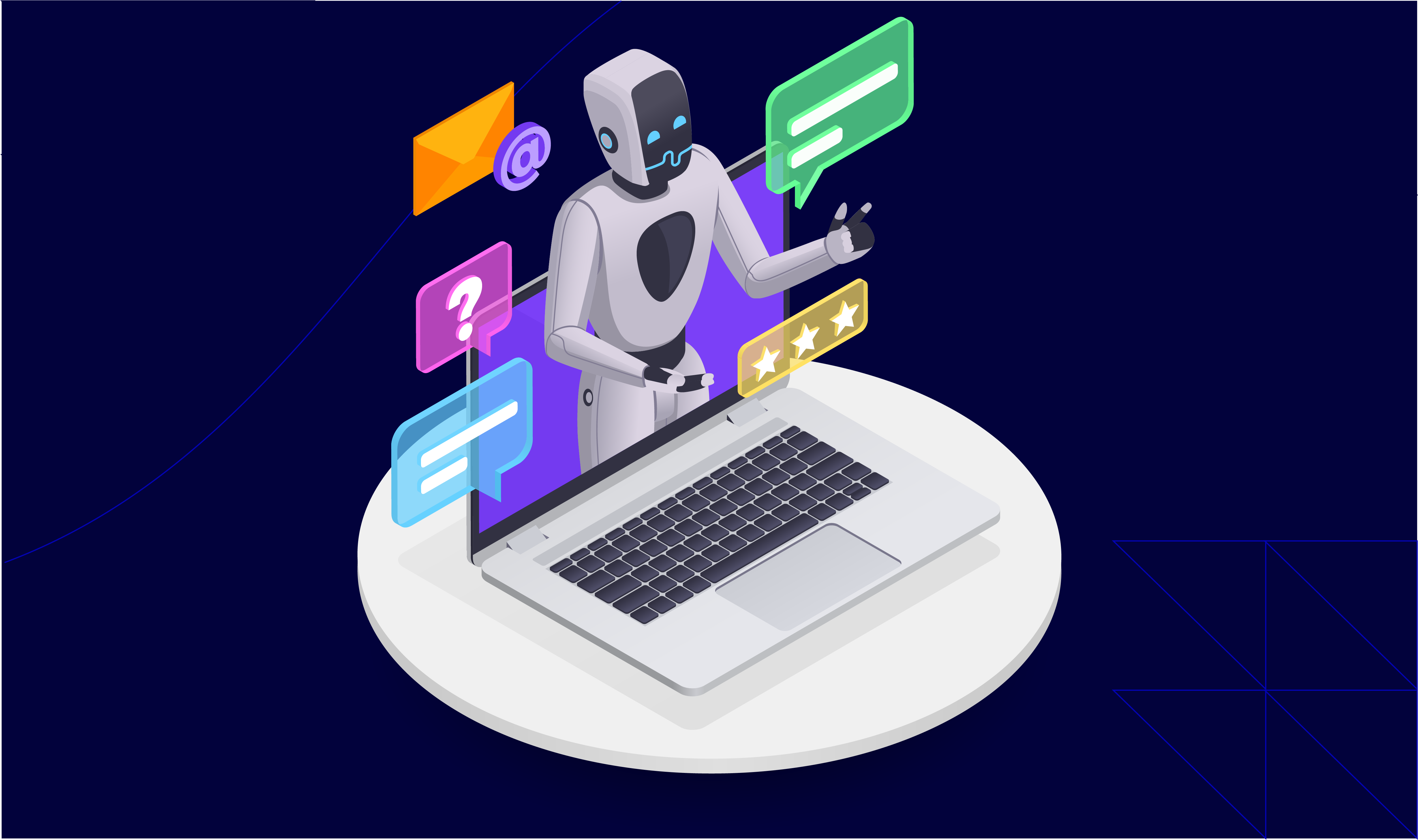To elevate customer servicei in 2025, most businesses are using AI and Machine Learning (ML) in 2025. Using them, you can predict customer needs, minimise resolution times, and automate routine tasks. Some proven techniques to achieve these benefits are AI-powered chatbots, Smart ticket clustering, AI-driven CSAT analysis, Proactive outreach automation, and more. Consumer and D2C brands are setting new standards in responsiveness and personalization.
Machine intelligence is the last invention that humanity will ever need to make!
Nowadays, this quote is making the rounds in the cabins of most customer experience (CX) professionals. It refers to two of the most advanced technologies:
- Artificial intelligence (AI)
- Machine learning (ML)
But why? According to Statista, 73% of digital professionals believe AI and ML will significantly impact CX. Even Intercom’s 2023 report, The State of AI in Customer Service, supports this view. The report states that 73% of business leaders expect AI-powered support to become the customer default choice by 2028.
If your brand hasn’t started using AI and machine learning in customer service yet, you’re already behind.
- More studies show that companies using AI in customer service have seen up to a 52% reduction in ticket resolution times.
- Also, AI adoption has led to a 68% reduction in staffing needs during peak seasons.
Don’t miss out on the benefits of using AI and machine learning in customer service! This guide explores six proven techniques to elevate customer service using AI and ML, along with real-world applications and results.
What is AI and Machine Learning in Customer Service?

Firstly, let’s understand what AI and ML are. Artificial Intelligence (AI) is a technology with capabilities of performing tasks that usually need human reasoning, like:
- Understanding language
- Analysing a situation
- Drawing conclusions
On the other hand, Machine Learning (ML) is a type of AI that learns from data. It looks at past interactions and finds patterns to make predictions or decisions.
Nowadays, both these technologies are widely used in a variety of business domains, including customer service. Studies show that about 80% of companies are already using AI in customer support interactions. Furthermore, by the end of 2025, AI and machine learning in customer service are projected to manage up to 95% of all service interactions (both voice support services and text).
But how? What are the practical applications of AI and machine learning in customer service? Let’s understand in our next section.
How to Use AI and Machine Learning in Customer Service in 2025? 6 Popular Techniques You Must Know!

Businesses are truly elevating customer service using both AI and ML! Studies show that by implementing AI in customer support, companies have achieved a 37% reduction in first response times.
Below are seven popular ways you can also use AI and ML to elevate your customer service in 2025:
1. Smart Ticket Clustering
Smart ticket clustering uses machine learning to group similar customer support requests. This grouping is based on:
- Keywords
- Intent
- Context
Instead of handling each ticket individually, the system identifies common themes and organises them into clusters. This allows support teams to address root causes at scale rather than just isolated incidents. Let’s check out how it is practised in different industries:
| SaaS Company | E-commerce company |
|
|
Major Benefits Achieved
- By addressing multiple related tickets at once, support teams can significantly cut their resolution time.
- Clustering highlights patterns in customer complaints. This allows businesses to resolve root causes and elevate customer service, a key driver for brand loyalty in D2C environments.
2. AI-Powered Chatbots with Natural Language Processing (NLP)
Modern AI chatbots use Natural Language Processing (NLP) to respond to customer queries with 100% more accuracy. NLP allows chatbots to:
- Comprehend complex language
- Identify intent
- Provide appropriate responses based on context
Please note that these chatbots are more advanced than basic rule-based bots! That’s because they can:
- Handle multi-step queries
- Deal with ambiguous phrases
- Even detect customer emotions
For example, Delta Air Lines uses an “Ask Delta” chatbot. This AI-powered chatbot manages tasks such as flight changes, baggage tracking, and check-ins. By handling these common requests, the chatbot reduces the number of calls to the contact centre.
Major Benefits Achieved
- “Sentiment analysis” technology in AI chatbots detects emotions in customer messages (such as frustration or confusion). If a customer expresses anger or dissatisfaction, the system escalates the interaction to a human agent for personalised handling.
- AI chatbots can provide multilingual responses without human translators. This allows businesses to offer continuous support regardless of location or time zone.
Atidiv uses similar NLP-driven chatbots to handle high-volume inquiries for retail and D2C clients, maintaining response accuracy above 99%.
3. Real-Time “Agent Assist” Tools
Real-time agent assist tools provide live support to customer service agents during interactions. These tools:
- Monitor live conversations
- Offer relevant suggestions to agents in real time
Also, they can share dynamic scripts and even detect communication errors (if any).
For example, Convin’s Agent Assist monitors customer interactions. It provides immediate guidance to agents. Say an agent starts to use overly technical language with a non-technical customer. Now, the tool tells the agent to give a simpler explanation to elevate customer service.
Two Major Features of Real-Time Agent Assist Tools
| A) Real-Time Coaching | B) Automated Post-Call Summaries |
|
|
Result: Agents become faster, more accurate and more confident, which is a hallmark of high-performance customer experience teams.
4. Hyper-Personalisation with ML Insights
Hyper-personalized service uses machine learning to improve customer service. It analyses customer data and delivers highly relevant recommendations and offers. To do so, ML systems study:
- Patterns in browsing history
- Purchase behaviour
- Previous interactions
Please note that this approach goes beyond basic segmentation. It tries to customise experiences to the individual level. For more clarity, let’s study an example related to Spotify’s Algorithm:
- Spotify uses ML to monitor users’ listening habits.
- It identifies:
- Favourite genres
- Frequently played songs
- Time-of-day listening patterns
- Based on this data, Spotify curates personalised playlists, such as the “Discover Weekly” playlist.
- It also suggests new music based on previous listening behavior.
A Popular Hyper-Personalisation Tool
“Dynamic Battlecards” are AI-generated, real-time information sheets for support agents. If a customer contacts support about a recent order, the battlecard displays relevant talking points such as:
- Order details
- Recommended products
- Ongoing promotions
Major Benefits Achieved
- Personalisation increases conversion rates by giving offers based on specific customer data.
- By delivering relevant recommendations, you can elevate customer service and earn repeat purchases.
5. AI-Driven CSAT Analysis
AI-driven Customer Satisfaction (CSAT) analysis goes beyond traditional surveys! It analyses 100% of customer interactions. Instead of waiting for customers to fill out a feedback form, these tools evaluate data from:
- Chat transcripts
- Emails
- Call recordings
Such an assessment of satisfaction levels is done automatically. For example:
-
- Crescendo.ai analyses customer interactions to assess sentiment and resolution outcomes.
- It examines factors such as:
- Tone
- Response time
- Overall sentiment
- Post-examination, it calculates a CSAT score.
- This score holds more relevance as it is based on more comprehensive feedback than isolated survey responses.
- It covers every interaction instead of a limited sample.
Popular Features of AI-Driven CSAT Analysis
| Root-Cause Filtering | Trend Visualisation |
|
|
Major Benefits Achieved
- Traditional CSAT surveys capture only a fraction of customer interactions. AI-driven analysis examines 100% of interactions. It provides a more accurate assessment of overall satisfaction.
- By identifying dissatisfaction triggers early, as a business owner, you can address root causes before they escalate. This reduces churn and elevates customer service standards.
Atidiv has applied similar CSAT automation to drive a 4.8 score across 200K+ annual interactions, demonstrating measurable CX improvement (read case study).
6. Proactive Outreach Automation
Proactive outreach automation uses machine learning to predict when customers might need assistance. Such a prediction is based on “data”, such as:
- Account activity
- Usage patterns
- Service history
Instead of waiting for customers to reach out with a problem, the system initiates contact with relevant information or offers. To understand better, let’s study some common examples in practice:
| SaaS Company | Telecom companies | Healthcare Providers |
|
|
|
Major Benefits Achieved
- Reduces customer churn by addressing issues (like data overages or feature changes) before they become full-fledged problems. This approach significantly prevents customer dissatisfaction.
- Proactive automation keeps customers informed about:
- New features
- Policy changes
- Service disruptions
AI and ML = Rocket Science? Outsource Customer Support to Atidiv in 2025!

Studies show that approximately 80% of customers who interacted with AI-powered customer support reported positive experiences. That’s largely because it reduces response times and leads to hyper-personalisation.
By using AI and machine learning in customer service, you can do:
- Smart ticket clustering
- AI-driven CSAT analysis
- Proactive outreach automation
- Real-time agent assistance
- Predictive analysis
However, to gain the most from these technologies, you need to make significant monetary investments and even need to train your entire agent team. Will it be tough for you? What if you can outsource customer support to a leading digital customer experience solutions provider?
Atidiv is a CX specialist with 15+ years of experience, 70+ global clients and a 4.8 CSAT. Our expert team uses AI and machine learning to elevate customer service. Let’s see how:
- Automate customer service workflows using AI chatbots and predictive analytics
- Analyze CX data for faster, smarter decision-making
- Leverage human-AI collaboration, escalations move seamlessly from bot to agent
- Using AI analytics systems, we monitor interactions and identify trends.
Case in Point: Atidiv helped a leading business aggregator save $20M+ while achieving 95%+ quality.
Modernize your customer support operations with Atidiv and deliver intelligent, empathetic service at scale. Reach out to us today!
FAQs On Elevate Customer Service
1. How can AI reduce my customer service costs?
By using AI in customer support, you can handle routine tasks (like order tracking and FAQs) through chatbots. This significantly shortens response times. Also, by clustering common issues, you can resolve multiple queries at once.
2. Will AI replace my customer support agents?
Human + AI = Maximum benefits!
Please realise that AI models can only complement your team by managing repetitive queries. They allow your agents to focus on complex or sensitive cases. Human + AI collaboration significantly improves their efficiency and elevates customer service.
3. Can AI in customer support prevent customer churn?
Yes, by using AI-ML-based systems, you can analyse patterns in customer behaviour. This lets you predict likely “churn risks”, such as:
- Slow website navigation
- Rude support staff
- Service disruptions
- Repetitive complaints of a specific product
Based on this information, you can take corrective actions and retain customers before they leave.

